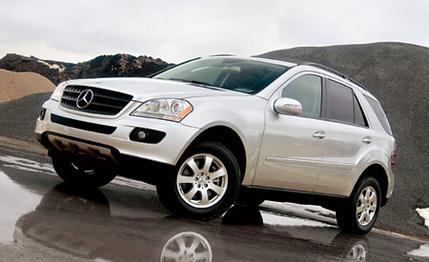 Road Test
Road Test
In the fall of 1997, Mercedes-Benz made history when it officially entered America's burgeoning sport-utility segment with its first-ever entry, the M-class. Representing more than a $1 billion investment, the M-class was not only the first Mercedes to be built in the U.S. but also the first to be produced in an all-new factory in Alabama, by a new workforce, using new production methods. As if the cards weren't stacked high enough, the M-class also utilized an all-new platform and V-6 engine. Apparently, Mercedes thrived on extreme challenges. It's no surprise, then, that the M-class proceeded to take Mercedes on a roller-coaster ride it would not forget.
That ride officially began for us in October 1997 ["Hill and Gully Riders"], when we pitted the all-new ML320 against a trio of established SUVs-the Jeep Grand Cherokee 5.9 Limited, the Land Rover Discovery SE7, and the Toyota 4Runner Limited. We came away so enamored of the M-class that we named it top dog. Not a bad title to claim when entering the marketplace. The roller coaster was looping high in the sky.
Unfortunately, many of the ML320's initial customers didn't share our joyful ride. Quality problems were prevalent in early vehicles and included malfunctioning key fobs, fuel gauges, power windows, and check-engine lights, as well as poor fit and finish of interior panels. M-class customers promptly ranked their vehicles last among luxury SUVs in J.D. Power's 1998 Initial Quality Study. The roller coaster was nose-diving. The following year, when the V-8-powered ML430 appeared, the M-class didn't fare much better in Power's IQS, again ranking near the bottom. Nonetheless, sales were strong and wait lists long-reportedly up to a year in some markets. Take a U-turn, roller coaster.
After eight years of riding the ups and downs, Mercedes is sick and tired, ready to exit this tumultuous ride. The cure? An all-new, second-generation M-class that Mercedes promises is not only free of the quality problems that plagued its predecessor but also more refined, more powerful, and more fuel efficient. And for that, Mercedes is asking $1830 more for a V-6 ML350 ($40,500) and $2100 more for a V-8 ML500 ($49,250).
Mercedes has gone to great lengths to make good on those promises. For starters, it has addressed quality shortcomings at its Alabama factory, investing another $600 million, with a big chunk going toward upping the number of robots, a move that gives Mercedes more control over vehicle quality and monitoring. Furthermore, because Mercedes decided the new M-class should drive and feel more like a car than a truck-seeing as that's what Americans seem to appreciate in SUVs- drastic measures were in order. So engineers and designers started with a clean sheet of paper, figuring any remnant of the previous vehicle was best left out in left field. They swapped the first generation's body-on-frame assembly-the method by which most trucks are built-for unibody construction, the same way Mercedes produces E- and S-class sedans. The result is a body that uses five times more high-strength steel and is significantly stiffer in torsional and bending rigidity.
Armed with the robust body, Mercedes focused on improving ride and handling, stretching the M-class's wheelbase by 3.8 inches, lowering the ride height by 0.4 inch, and widening the front and rear tracks by nearly 4.0 inches-all of which complements a revised four-wheel independent suspension that features control arms up front and a new four-link arrangement in back. Plus, Mercedes' adjustable Airmatic DC air suspension, not fitted on our tester, is now optional.
The old M-class's two-speed transfer case has been dropped-although a two-speed transfer case will be offered later as part of an off-road package that also includes locks for the center and rear differentials-and is replaced with full-time four-wheel drive that uses three conventional open differentials and a four-wheel electronic traction-control system that varies torque front to rear and side to side. Although every M-class comes standard with a center-console-mounted "Off-Road" button-which alters ABS, traction control, shift points, and throttle sensitivity to ease maneuvering-Mercedes' new ute is more suited for crossing intersections than fiords, at least till the hard-core off-road package debuts. Other new features include larger four-wheel disc brakes, as well as optional speed-sensitive power rack-and-pinion steering and 19-inch wheels fitted with 50-series tires.
The M-class still looks like a wedge, but it has lost much of the original's boxy façade, especially in the rear. It now appears sleeker and sportier, thanks to integrated fender flares, a sharply raked windshield, and a longer (by 5.6 inches) and wider (by 2.8 inches) body, which now cuts through the atmosphere with a 0.34 Cd, improved from 0.39. From some angles-namely, in profile-the new M-class looks like a mix between the original and a Chrysler Pacifica. But unlike the Pacifica, or the original for that matter, the new M-class will not be available with a third row of seats. Mercedes is leaving the extended-family hauling to its upcoming R- and G-classes.